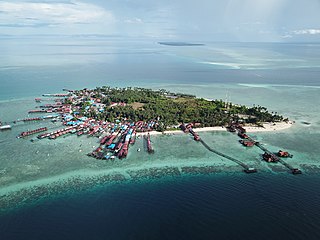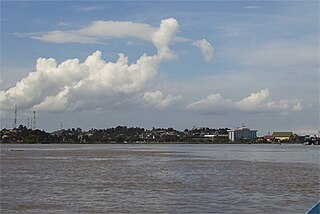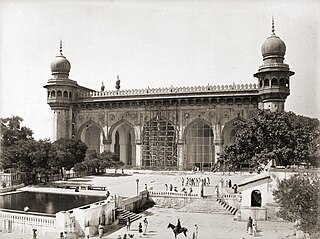
Makkah Masjid or Mecca Masjid, is a congregational mosque in Hyderabad, India. It is one of the largest mosques in India with a capacity of 20,000. The mosque was built between the 16th and 17th centuries, and is a state-protected monument situated in the heart of the old city of Hyderabad, close to the historic landmarks of Charminar, Chowmahalla Palace and Laad Bazaar.
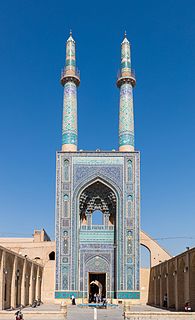
The Jāmeh Mosque of Yazd is the grand, congregational mosque (Jāmeh) of Yazd city, within the Yazd Province of Iran. The mosque is depicted on the obverse of the Iranian 200 rials banknote.

Baiturrahman Grand Mosque is a Mosque located in the center of Banda Aceh city, Aceh Province, Indonesia. The Baiturrahman Grand Mosque is a symbol of religion, culture, spirit, strength, struggle and nationalism of the Acehnese people. The mosque is a landmark of Banda Aceh and has survived the 2004 Indian Ocean tsunami.
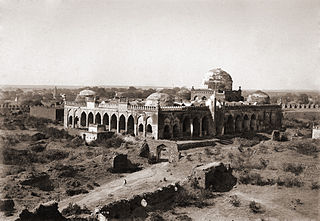
Jama Masjid Gulbarga is Mosque located in Gulbarga City, Karnataka, India. It is regarded as one of the best examples of mosque architecture in South Asia. The arches design of Jama Masjid Gulbarga reflects in the interiors of Spanish Mosque of Hyderabad, India. These are only two mosques in India which have interiors similar to the Great Cathedral–Mosque of Córdoba in Spain.

Great Mosque of Medan or Masjid Raya Al Mashun is a mosque located in Medan, Indonesia. The mosque was built in the year 1906 and completed in 1909. In beginning of its establishment, the mosque was a part of the Maimun palace complex. Its architectural style combines Middle Eastern, Indian and Spanish elements. The mosque has an octagonal shape and has wings to the south, east, north and west.

The Baitul Aman Jame Masjid Complex, commonly known as Guthia Mosque of Barisal, is a mosque complex of Bangladesh having a land area of 14 acres, comparing to the 8.30 acres land area of the national mosque Baitul Mukarram of the country. The Baitul Aman Jame Masjid Complex consists of a Mosque, a huge Eidgah, a graveyard, three lakes, Madrasa and an orphanage. Established on December 16, 2003, Guthia Mosque is also a tourist spot in Bangladesh.

The Great Mosque of Palembang, also known as Sultan Mahmud Badaruddin I Great Mosque after the former Sultan of Palembang, is the main mosque of Palembang, the capital of South Sumatra. The mosque is the largest in South Sumatra, and the third largest mosque in Sumatra after the Grand Mosque of West Sumatra and Great Mosque of Pekanbaru.

The Grand Mosque of Bandung, previously known as the Great Mosque of Bandung, is a mosque in Bandung, the provincial capital of West Java, Indonesia. The mosque received the status of provincial mosque of West Java Province in 2004. It is located on the east side of the alun-alun of Bandung.

Andalas Grand Mosque is a mosque located in Andaleh Street no.56, Andaleh, East Padang district, Padang, West Sumatra, Indonesia. The mosque consists of a green building with two floors which has area of 1,200 m2, and a minaret in the southeast and an entrance gate in the south.
Masjid Raya Syekh Burhanuddin is one of the oldest mosques as well as a cultural heritage in West Sumatra, Indonesia. The mosque is located in Nagari Ulakan, Ulakan Tapakis sub-district, Padang Pariaman district of West Sumatra.
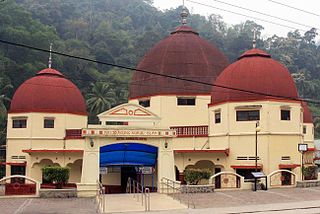
The Nurul Islam Great Mosque or also known as Sawahlunto Great Mosque is one of the oldest mosques in Indonesia located in Kubang Subdistrict of North Sirakuak, District of Lembah Segar, Sawahlunto town, West Sumatra. The location is about 150 meters from the Sawahlunto Railway Museum.

Rao Rao Mosque is one of the oldest mosques in Indonesia located in Nagari Rao Rao, Tarab River, Tanah Datar District, West Sumatra. It is located on the road from Batusangkar bound to Bukittinggi, precisely in Rao Rao. This mosque of Minangkabau and Persian architecture was built in 1908 with a roof made from fibers before being changed to zinc.

Al-Akbar Mosque, also known as Great Mosque of Surabaya, is a national mosque located in Surabaya, East Java. It is the second largest mosque in Indonesia after Istiqlal Mosque in Jakarta in terms of maximum capacity. The location of the mosque is beside the Surabaya-Porong Highway Road. Its most distinctive feature is its large vertical dome, accompanied by four small blue domes. It also has a minaret with height of 99 meters, an ode to the 99 Names of Allah.

Dian Al-Mahri Mosque, also known as Golden Dome Mosque(Masjid Kubah Emas), is a mosque built on the edge of Raya street, Depok City in West Java, Indonesia. In addition to being a place of worship for everyday Muslims, this mosque complex is also a tourist area for family and attracts many people because of its domes made of gold. Because of the vastness of area and accessibility to the public, this place is often a holiday destination for family or a place to take a rest.
KH Hasyim Asy'ari Grand Mosque is a newly built mosque at Semanan, Kalideres, West Jakarta, Indonesia. The mosque is named after National Hero of Indonesia Hasyim Asy'ari, the founder of the Nahdlatul Ulama. The mosque was inaugurated by Joko Widodo, President of Indonesia on 15 April 2017. The mosque is the first which is fully operated by Jakarta city administration.
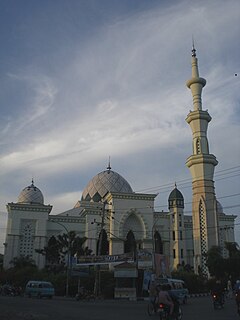
Great Mosque of Makassar is a mosque located in Makassar, Indonesia, and the main mosque of South Sulawesi Province. The construction begun in 1948 and completed in 1949. Since then the mosque underwent a renovation from 1999 to 2005. The mosque can accommodate up to 10,000 worshipers, making it one of the largest mosques in Southeast Asia.
The Al-Mansur Mosque is one of the oldest mosques in Jakarta, Indonesia. The mosque is located at Jembatan Lima, Tambora, Jakarta. The mosque is one of the listed cultural heritage of Jakarta. The mosque is named after Kh. Mohammad Mansur who is familiarly called Guru Mansur- a Betawi figure known for his fight against Dutch colonial rules.

Grand Mosque of Kubang Putih is an early 19th-century mosque located in the town of Kubang Putiah, West Sumatra, Indonesia. The mosque is designated as a cultural heritage object along with several other old mosques in West Sumatra, such as Bingkudu Mosque in Agam, Rao Rao Mosque in Tanah Datar, and the Ganting Grand Mosque in Padang.

